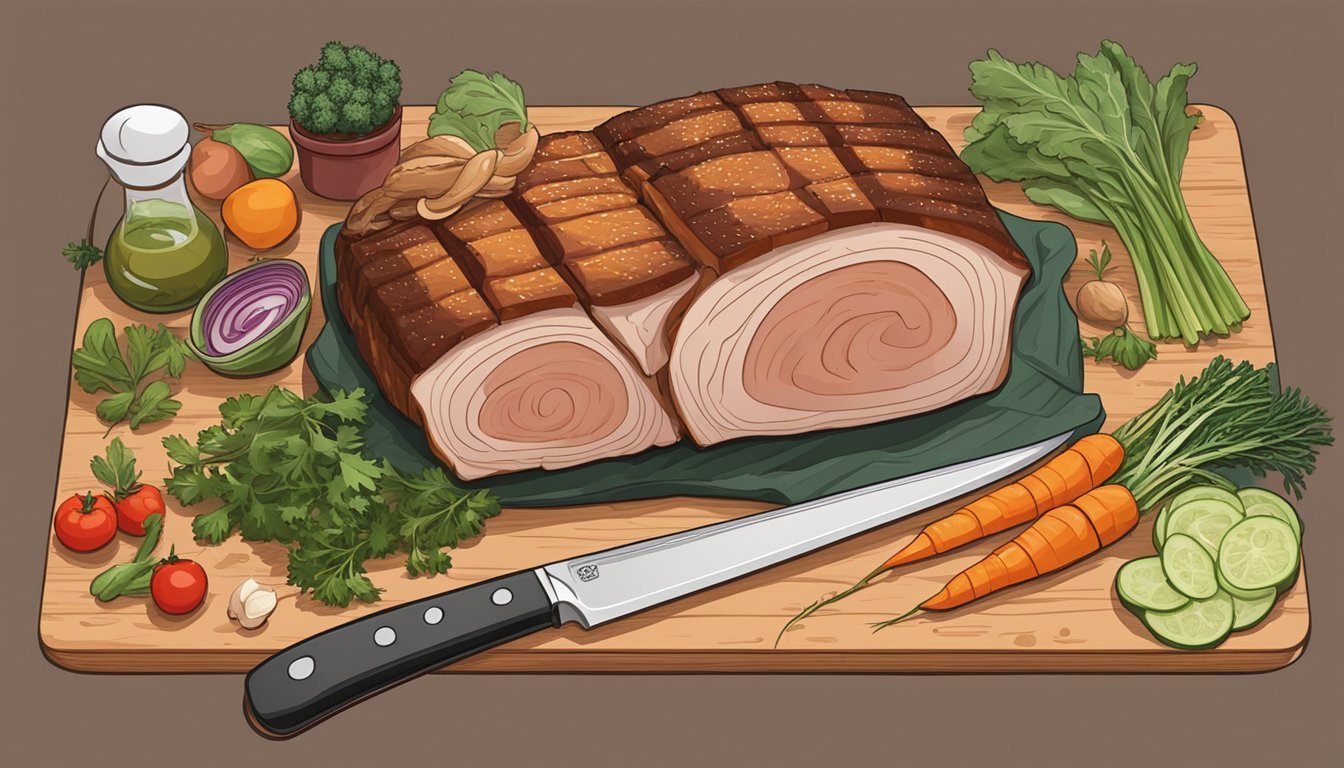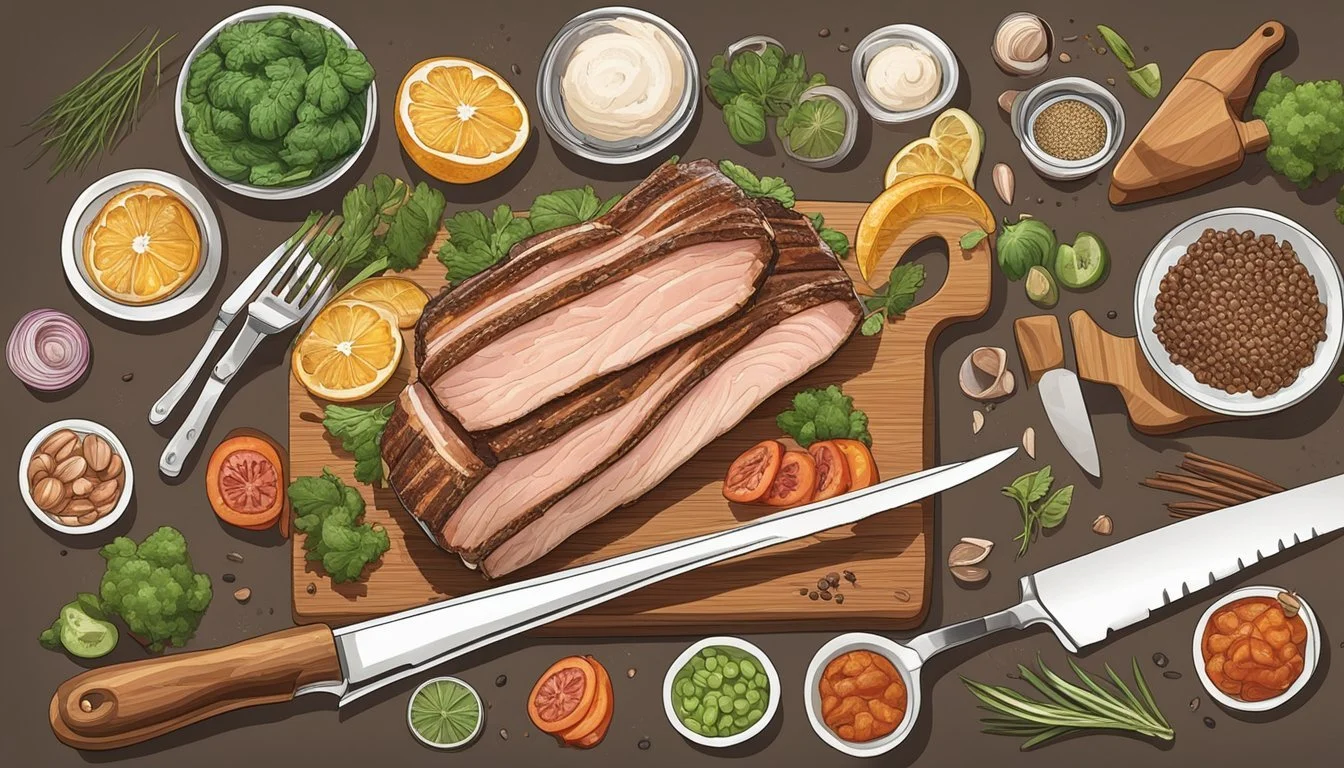How do you eat a pork belly?
Mastering the Art of Savory Indulgence
Pork belly (What wine goes well with pork belly?), a rich and flavorful cut of meat coveted for its succulent fat layers and tender meat, has long been a staple in various cuisines around the world. Recognized primarily for its use in making bacon, pork belly far exceeds this single application. This versatile ingredient can be prepared using multiple cooking methods including braising, roasting, and frying to highlight its delicious taste and texture.
Eating pork belly allows for an exploration of flavors and textures that are deeply satisfying. To fully enjoy its potential, it often requires slow cooking to render the fat and tenderize the muscular portions, resulting in a mouthwatering combination of crispy exterior and melt-in-your-mouth interior. Preparing pork belly by cutting it into slices or cubes depends on the chosen cooking technique, but common to all methods is the initial step of ensuring the pork belly is correctly scored and seasoned.
Once cooked, pork belly can be served in various ways, from being the centerpiece of a dish to being incorporated into soups, sandwiches, and salads. It is crucial to balance its richness with sides or condiments that can cut through the fat and complement its robust flavor. Whether enjoyed as part of a sophisticated meal or a simple comfort dish, pork belly remains a testament to the delights of hearty cooking.
Selecting Quality Pork Belly
Selecting a quality pork belly is essential for enjoying this delicacy at its best. The key elements involve assessing the product's freshness, choosing a suitable cut, and understanding the various grades of pork belly.
Assessing Freshness
When examining a pork belly at the grocery store or local butcher's shop, one should look for meat that possesses a vibrant pink hue. The fat should be white or cream-colored, not yellow, which can indicate age. Any pork belly should exhibit a fresh, mild smell; any off odors are immediate red flags.
Picking the Right Cut
A well-balanced pork belly cut is integral to the creation of a succulent dish. The meat-to-fat ratio should be even, with layers of meat interspersed with layers of fat. A fatty cut is desirable, but an excess can result in overly greasy food, while too little can produce a dry outcome. Obtain a thick, evenly trimmed piece to guarantee consistent cooking and a rich flavor.
Understanding Pork Belly Grades
Pork belly grades can vary, although specific grading systems like USDA grades for pork belly are not always used as they are for cuts like beef. However, when available, higher grades indicate a higher quality of meat, with considerations given to factors such as the distribution of fat and the texture of the meat. It is recommended to seek advice from one's local butcher when questioning the grade and quality of pork belly.
Preparation Basics
Before diving into cooking pork belly, it's essential to prepare the meat properly. The preparation process involves trimming excess fat, scoring the skin, and applying seasonings or marinades to enhance the flavor.
Trimming the Meat
Trimming is a crucial step to remove any excess fat that won't render out during cooking, ensuring a balanced ratio of meat and fat. One should leave a sufficient layer of fat to keep the meat moist and flavorful. A sharp knife should be used to trim off any tough or excessive fat from the meat's surface.
Scoring the Skin
Scoring the skin of the pork belly is vital for two reasons: it allows heat to penetrate more effectively, and it assists in rendering the fat, resulting in a crispier skin. With a sharp knife, it's recommended to make diagonal cuts through the skin, about 1/4 inch apart, being careful not to cut into the meat itself.
Seasoning Techniques
A proper seasoning technique can make a significant difference in flavor. Generously seasoning the pork belly with salt and pepper is essential. For enhanced flavor, chefs often rub the pork belly with a mix of sea salt, garlic powder, and cayenne pepper. The spices should be massaged into the cuts and layers of the pork belly to ensure even distribution.
Marinating Options
Marinating the pork belly can impart deep flavors and add succulence to the meat. Common ingredients for a marinade might include olive oil, garlic, and a blend of desired spices. A typical marinade might be left on the pork belly for several hours or even overnight, which allows the flavors to penetrate the meat's layers.
Cooking Methods
When preparing pork belly, different cooking methods can be employed to achieve various textures and flavors. Whether aiming for crispy skin or tender meat, each technique requires careful attention to heat levels and cooking times.
Oven Roasting Pork Belly
One achieves crispy pork belly by slow roasting it in the oven. One should preheat the oven to a low temperature, typically between 275°F to 350°F. The pork belly is placed on a rack in the roasting pan to ensure even cooking and crispy skin. It should be seasoned to preference, then slow-roasted until tender—often 2 to 3 hours. To finish, one may increase the oven temperature or use the broiler for a short duration to crisp the skin further.
Braising Pork Belly
Braising involves cooking the pork belly in liquid at low heat, a method that yields a tender and flavorful result. One typically starts by searing the pork belly in a hot pan to develop a flavorful crust. After searing, the meat is placed in a pot with a mixture of liquids like stock, wine, or a marinade, covered with a lid or aluminum foil, and then cooked in the oven at a low temperature for several hours until it becomes fork-tender.
Pan Frying Pork Belly
To pan-fry pork belly, one begins by slicing it into pieces and seasoning accordingly. A skillet is heated over medium-high heat before the pork belly slices are added. They require frequent flipping to ensure even cooking and are fried until each side is browned and the fat has rendered. The process typically results in a rich, crispy outer texture while keeping the inside juicy.
Grilling Pork Belly
Grilling pork belly imparts a smoky flavor that is highly sought after in BBQ dishes. It is crucial to first preheat the grill to a high heat for searing and then to a lower temperature to cook the meat through. One often starts with the skin-side down to render the fat and achieve crispy skin, then flips the pork belly to grill the other side. On a charcoal grill, maintaining indirect heat can prevent flare-ups and ensure a slow roast to keep the meat moist and tender.
Serving Suggestions
When serving pork belly, it is important to balance its richness with accompaniments that can either enhance its flavor or provide a refreshing contrast.
Side Dishes
Pork belly pairs well with a variety of side dishes that can range from starchy to light and refreshing.
Starchy Sides:
Rice: A classic pairing, rice works well to soak up the pork belly's juices.
Potato Salad: Creamy potato salad offers a comforting complement.
Light Sides:
Salad: A crisp cucumber radish salad provides a refreshing counterpoint.
Veggies: Steamed vegetables with a sprinkle of feta cheese add a healthful touch.
Condiments and Toppings
The right condiments and toppings can greatly enhance the pork belly dining experience.
Soy Sauce: A drizzle of soy sauce adds umami and depth to the meat.
Other condiments can include:
Apple and fennel salad for a tangy crunch.
Lemon garlic dressing for a zesty kick.
Plating Techniques
Presentation matters when serving pork belly and can affect the overall dining enjoyment.
Sandwich: Layering thinly sliced pork belly in a sandwich showcases the meat.
Tacos: Encasing pork belly in tacos offers a handheld delight with every bite.
Each component on the plate should have its space, allowing diners to appreciate the appearance before diving into the flavors.
Storing and Reheating Leftovers
When dealing with pork belly leftovers, one must ensure proper storage to maintain freshness and reheating to preserve texture and flavor.
Storing in Refrigerator
Leftovers should be placed in an airtight container and stored in the refrigerator. It's crucial to refrigerate pork belly within two hours of cooking to prevent the growth of bacteria. Properly stored, it can be safe to consume for up to four days.
Freezing Pork Belly
For longer preservation, leftovers can be frozen. Wrap the pork belly tightly in plastic wrap or aluminum foil, then place it in an airtight container or heavy-duty freezer bag. One can freeze pork belly for up to three months without significant loss of quality.
Reheating Methods
Reheating should strive to replicate the original cooking process to retain the pork's moistness and crispiness.
Oven Method:
To reheat in the oven, preheat it to 350°F (175°C).
Wrap the meat in aluminum foil with a tablespoon of stock or water to keep it moist.
Heat for 10-15 minutes, then uncover and broil the skin separately for crispiness.
Alternative Reheating:
Aside from the oven, one can use a skillet or microwave for quicker reheating.
For the skillet method, a bit of oil on a pan over medium heat can warm the slices effectively.
If using a microwave, cover the pork with a damp paper towel and heat it on medium power in short intervals to avoid drying out the meat.
Using the above methods, one ensures the pork belly retains its desirable qualities when consumed as leftovers.
Health and Dietary Considerations
When consuming pork belly, individuals should consider its nutritional profile, how it fits into specific diets such as keto and paleo, and be aware of any potential allergens.
Nutritional Information
Pork belly is a rich, fatty cut of meat that provides substantial protein. It is also high in saturated fat, which should be consumed in moderation within the context of a balanced diet. A typical 4-ounce serving contains approximately:
Calories: 435
Protein: Varies (significant source)
Fat: Predominantly saturated and monounsaturated
Vitamins and minerals: Notable for niacin, vitamins B6 and B12, iron, zinc, phosphorus, selenium, and thiamine
Keto-Friendly Preparations
Due to its high fat content, pork belly can be an ideal ingredient for those following a keto diet, which focuses on high-fat, low-carbohydrate foods. To ensure the dish is keto-compliant, one should:
Use sugar-free seasonings and marinades
Avoid glazes or sauces with added sugars or high-carb ingredients
Paleo dieters may also include pork belly in their meals, provided it's sourced from pasture-raised pigs and prepared without artificial additives.
Paying Attention to Allergens
While pork belly itself is not known to contain common allergens, it's important to consider additives or cross-contaminants that may be present in pre-packaged products. Individuals with food sensitivities should look for:
Gluten-free certification if sensitive to gluten
Information on potential cross-contamination from nuts or other allergens in processing facilities
Advanced Cooking Techniques
In this section, we'll explore methods for achieving a perfectly crispy crackling and discuss the best practices for applying glazes and sauces to enhance the flavor and presentation of pork belly.
Creating Crispy Crackling
To create crispy crackling on pork belly, one must ensure the skin is scored and dried thoroughly. Scoring the skin—making shallow cuts about 1 cm apart—allows the fat underneath to render out during the cooking process, which contributes to the crispiness. Here are the steps:
Score: Gently score the pork belly skin without cutting into the meat.
Dry: Pat the skin dry with paper towels, and if time allows, leave the scored pork belly uncovered in the refrigerator for several hours, ideally overnight.
Season: Rub the skin with coarse salt, which helps to draw out moisture.
Roast: Start the roast at a high temperature, around 450 degrees F (230 degrees C) for 10-15 minutes, then lower the temperature to around 325 degrees F (160 degrees C) to cook through.
Applying Glazes and Sauces
Enhancing pork belly with glazes or sauces adds layers of flavor and can also contribute to the texture of the crackling. The application should be timely to avoid burning the sugars present in the glaze.
Honey Glaze: Combine honey with a touch of apple cider vinegar and a splash of soy sauce for a balanced, sweet, and savory finish. Apply the glaze during the last 20-30 minutes of roasting, so it caramelizes but doesn't burn.
Sauces: Serve the roasted pork belly with a side of sauce to complement the rich flavors. A sauce such as a tangy barbecue or a spicy chili sauce can be drizzled over the pork just before serving or provided on the side for dipping.
These techniques can elevate the final dish, creating a memorable eating experience with balanced flavors and irresistible textures.
Cultural Variations
Pork belly, enjoyed across the globe, has unique preparations that reflect each culture's culinary heritage. These variations showcase diverse cooking methods and flavor profiles, ranging from the umami-rich seasoning in Asian cuisine to the robust and hearty styles found in Hispanic dishes.
Chinese Pork Belly
In Chinese cuisine, pork belly is a revered component, often prepared with a focus on achieving a balance between flavor and texture. Cantonese style roast pork belly, or Siu Yuk, is celebrated for its crispy skin and tender, flavorful meat. The secret to its savory taste lies in the combination of umami notes derived from ingredients like soy sauce and five-spice powder. The method involves roasting the pork with a layer of sea salt, which is later removed to reveal the quintessentially crispy skin.
Korean Pork Belly
Korean culinary tradition embraces pork belly in a dish called Samgyeopsal, where slices of pork are grilled at the table and oftentimes served with a variety of side dishes known as banchan. It's typical to enjoy the grilled meat wrapped in lettuce leaves, garnished with garlic, chili pepper, and a dab of ssamjang (a thick, spicy paste). The intrinsic umami of the pork belly is complemented by the complex flavors of these accompaniments, presenting a well-rounded and interactive dining experience.
Hispanic Pork Belly
Hispanic kitchens integrate pork belly into a range of hearty dishes. The meat is typically seasoned with robust spices and herbs, creating a full-bodied profile that pairs well with starch-heavy sides like rice and beans. Hispanic cooks often braise or slow-roast the pork belly, allowing the fat to render and the cut to become remarkably tender, producing a dish that is both comforting and deeply satisfying on a gastronomic level.
Professional Tips from Chefs
When preparing pork belly, chefs emphasize the importance of using appropriate equipment, precise temperature control, and flavor enhancement to achieve a succulent texture and rich taste. The right approach can transform a simple slab of pork into a gourmet dish.
Selecting the Right Equipment
To properly cook pork belly, chefs recommend using a heavy, oven-safe pan or a roasting rack to ensure even cooking. A sharp knife is essential for scoring the skin, which aids in rendering the fat and achieving a crisp texture.
Mastering Cooking Temperatures
The temperature plays a pivotal role in cooking pork belly. Chefs advise starting with a high heat (around 400°F) to crisp the skin and then lowering the temperature (to around 250°F) to slowly cook the meat until it's tender. Precise temperature control allows the fat to render properly, basting the meat and enhancing its succulence.
Enhancing Flavors
Chefs suggest seasoning the pork belly generously before cooking to enhance its natural flavors. Common seasonings include salt, pepper, and paprika. Infusing the meat with aromatic herbs like rosemary or thyme during the roasting process can also contribute to the dish's depth of flavor. After cooking, allowing the pork belly to rest ensures that the juices redistribute, making each bite as flavorful as possible.
Recipe Ideas and Innovations
Exploring the culinary landscape of pork belly reveals a rich tapestry of classic recipes, contemporary innovations, and thoughtful drink pairings. Each subsection underscores the versatility of pork belly in the kitchen.
Classic Recipes
Pork belly has been a staple in many cultures due to its rich flavor and tender texture. One timeless method is the slow roasting technique, which involves cooking pork belly at a low temperature to render the fat and tenderize the meat. A popular classic pork belly recipe involves:
Preheating the oven to about 350 degrees Fahrenheit
Mixing olive oil, apple cider vinegar, garlic, rosemary, and thyme to create a rub
Massaging the rub over the meat, avoiding the skin for a crisp finish
Modern Twists
Chefs today are reimagining pork belly with creative and modern renditions. For those looking to push the boundaries, modern pork belly recipes can include:
Utilizing Asian flavors, such as glazing pork belly with a mixture of soy sauce, garlic, and peppercorns
Experimenting with unconventional seasoning combinations or marinating in citrus-based concoctions for a fresh zest
Table 1: Ingredients for a Modern Pork Belly Glaze
Ingredient Measurement Soy Sauce 1/4 cup Garlic (minced) 2 cloves Peppercorns 1 teaspoon
Pairing with Drinks
To elevate the pork belly experience, one should pair the dish with a drink that complements its rich flavors. For classic roasted pork belly with a crisp skin, a full-bodied white wine or a light, fruity red can balance the fattiness. For spiced or sweetened pork belly, an off-dry Riesling or a smooth bourbon can enhance the complex flavors.
List of Drink Pairings for Pork Belly:
Full-bodied white wines such as Chardonnay
Light, fruity red wines like Pinot Noir
Off-dry Riesling for sweet and spicy pork
Smooth bourbons for a smoky finish
Buying Guide
When purchasing pork belly, the savvy shopper considers retail options, curing status, and bulk availability. These factors influence the quality, flavor, and potential uses of pork belly in culinary applications.
Retail vs Butcher Shop
Retail Grocery Stores:
Shopping Experience: They may offer convenience and competitive pricing.
Selection Variety: The selection may be limited and vary by geographical location.
Local Butcher Shops:
Shopping Experience: They boast specialized expertise and can provide custom cuts.
Selection Quality: Local butchers are likely to source higher-quality, fresher meats with a potential focus on heritage breeds.
Cured vs Uncured
Cured Pork Belly:
Main Features: Pre-seasoned with a curing salt mixture, possibly smoked.
Use Cases: Ideal for those seeking robust flavors or making charcuterie dishes like bacon.
Uncured Pork Belly:
Main Features: No additives; it's in its natural state, which allows for more culinary flexibility.
Use Cases: Best for those who prefer a fresher taste or want to apply their own seasoning and cooking techniques.
Bulk Purchases
At Grocery Stores:
Price: Often more cost-efficient in bulk.
Storage Considerations: Requires ample freezer space, especially for larger families or commercial use.
Through Butchers or Wholesalers:
Quality: They may offer premium bulk options, which may influence the overall taste of final dishes.
Bulk Options: They can provide insights into the best bulk deals tailored to the customer's specific needs.
Cookware and Utensils
Preparing pork belly requires specific cookware and utensils for optimal results. This includes the proper selection of a cutting board, skillet, baking dish, and other essentials for handling, cooking, and maintaining your equipment.
Essential Kitchen Tools
For cooking pork belly, one needs a sturdy skillet for searing, a baking dish for roasting, and aluminum foil to cover the meat if necessary. Additionally, having paper towels on hand is crucial for patting the pork belly dry to ensure a crisp exterior when cooked.
Skillet: Suitable for searing pork belly slices.
Baking Dish: Employed for oven roasting.
Aluminum Foil: Utilized for covering the pork belly during certain cooking stages.
Paper Towels: Used for drying the skin for crispiness.
Using a Cutting Board
A cutting board is essential for slicing pork belly into portions before cooking. One should opt for a cutting board that is durable and spacious enough to handle the size of the pork belly. Using a non-slip cutting board ensures safety when slicing through the pork's layer of fat and meat.
Cutting Board: A necessity for safe slicing and portioning.
Maintenance and Care
After cooking, one should clean all utensils thoroughly. The skillet should be cleaned according to its specific material, whether it is cast iron or non-stick. Baking dishes require soaking and scrubbing to remove any residue. Cutting boards must be sanitized after use to prevent cross-contamination. Tools like aluminum foil are disposable and should be discarded after use.
Skillet & Baking Dish: Clean according to material guidelines.
Cutting Board: Disinfect after each use to prevent cross-contamination.
Aluminum Foil: Discard after use, as it is not reusable.
Finishing Touches
After the pork belly has been cooked to perfection, the final steps are pivotal to elevate the dining experience. These steps ensure that each bite is a harmonious combination of flavors and textures.
Garnishing for Presentation
A thoughtful garnish not only adds visual appeal but also introduces complementary flavors. Chefs might add freshly chopped herbs like parsley or cilantro for freshness, or they could use thinly sliced green onions for a mild kick. Citrus zest can provide a pleasant aroma and a tangy note that cuts through the richness.
Herbs: Sprinkle chopped herbs generously.
Citrus Zest: Grate over the top for a fragrant finish.
Creating Texture Contrasts
The allure of pork belly lies in its textural variety. Achieving a crisp skin while maintaining tender meat underneath is the goal. Sometimes a finishing technique under the broiler or a quick sear on a hot pan might be employed to ensure that coveted crunch.
Skin Crispness: Broil briefly if needed for extra crispiness.
Juiciness: Serve immediately to preserve the internal succulence.
By focusing on these finishing touches, one ensures that the final dish is not only visually appealing but also a delight to the palate with layers of texture.
Food Safety
When preparing and consuming pork belly, two critical factors to ensure food safety are appropriate handling and storage, as well as monitoring the meat's internal temperature.
Proper Handling and Storage
Pork belly should be refrigerated or frozen as soon as possible after purchase to prevent bacterial growth. Storage temperatures should be maintained at 40°F (4°C) or below if refrigerating, and at 0°F (-18°C) or below if freezing. It is important to never leave pork belly at room temperature for more than two hours. Additionally, one should never defrost pork belly at room temperature; instead, thaw it in the refrigerator, under cold water, or in the microwave if it is to be cooked immediately.
Monitoring Internal Temperature
Cooking pork belly to the correct internal temperature is vital for safety. Use a meat thermometer to ensure that pork belly reaches a minimum internal temperature of 145°F (63°C) before removing it from the heat source. For optimal safety and quality, allow the meat to rest for at least three minutes before carving or serving. This resting period allows the temperature to continue to rise slightly and kills any remaining harmful bacteria.














